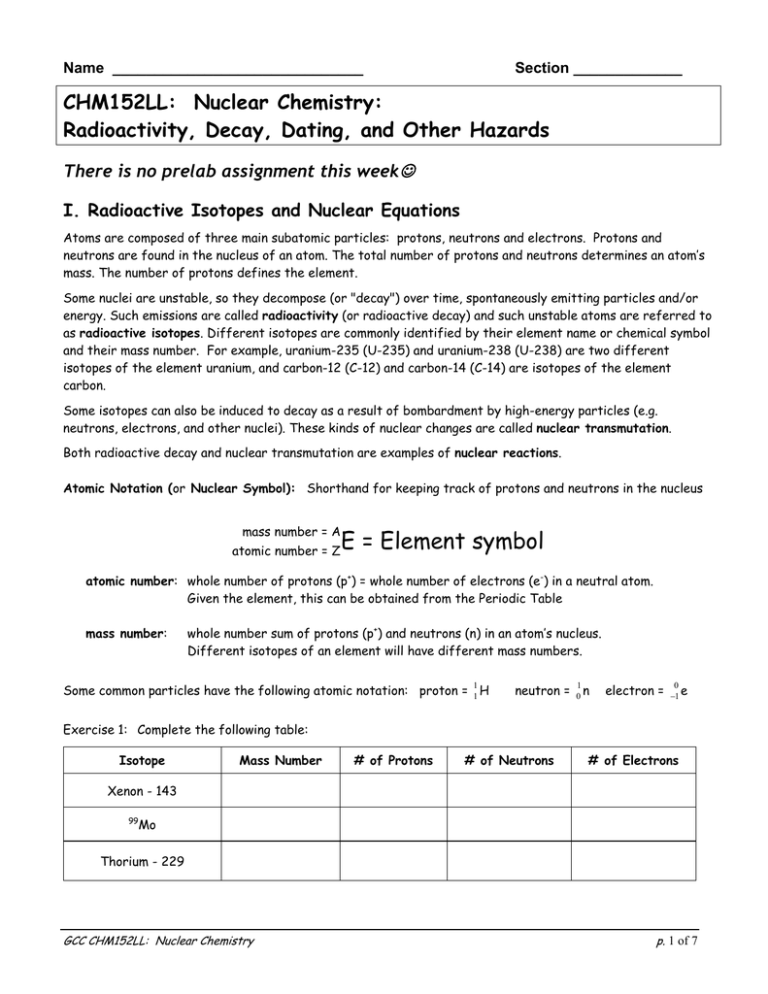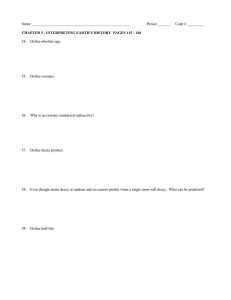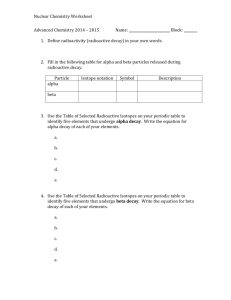atomic number = ZE = Element symbol
advertisement

Name ______________________________ Section _____________ CHM152LL: Nuclear Chemistry: Radioactivity, Decay, Dating, and Other Hazards There is no prelab assignment this week I. Radioactive Isotopes and Nuclear Equations Atoms are composed of three main subatomic particles: protons, neutrons and electrons. Protons and neutrons are found in the nucleus of an atom. The total number of protons and neutrons determines an atom’s mass. The number of protons defines the element. Some nuclei are unstable, so they decompose (or "decay") over time, spontaneously emitting particles and/or energy. Such emissions are called radioactivity (or radioactive decay) and such unstable atoms are referred to as radioactive isotopes. Different isotopes are commonly identified by their element name or chemical symbol and their mass number. For example, uranium-235 (U-235) and uranium-238 (U-238) are two different isotopes of the element uranium, and carbon-12 (C-12) and carbon-14 (C-14) are isotopes of the element carbon. Some isotopes can also be induced to decay as a result of bombardment by high-energy particles (e.g. neutrons, electrons, and other nuclei). These kinds of nuclear changes are called nuclear transmutation. Both radioactive decay and nuclear transmutation are examples of nuclear reactions. Atomic Notation (or Nuclear Symbol): Shorthand for keeping track of protons and neutrons in the nucleus mass number = A atomic number = Z E = Element symbol atomic number: whole number of protons (p+) = whole number of electrons (e-) in a neutral atom. Given the element, this can be obtained from the Periodic Table mass number: whole number sum of protons (p+) and neutrons (n) in an atom’s nucleus. Different isotopes of an element will have different mass numbers. Some common particles have the following atomic notation: proton = 1 H 1 neutron = 0 n 1 electron = 0 1 e Exercise 1: Complete the following table: Isotope Mass Number # of Protons # of Neutrons # of Electrons Xenon - 143 99 Mo Thorium - 229 GCC CHM152LL: Nuclear Chemistry p. 1 of 7 Modes of Decay There are five different ways in which naturally occurring radioactive nuclei decay. Note that in emission reactions, often called decay reactions, the particle is a product. In the capture reaction, the particle is a reactant. alpha () emission (or decay): a helium nucleus, 4 2 α or 4 2 He , is emitted. In this case, the parent and daughter are atoms of different elements and also have different masses. 238 92 beta () emission (or decay): U an electron, 0 -1 or 0 -1 4 2 α 234 90 Th e , is emitted when a neutron inside an atom decays to produce a proton and an electron. In this case, the parent and daughter are of different elements but the mass remains the same. 234 90 gamma ( emission (or decay): Th 0 -1 β 234 91 Pa high energy photons or gamma rays, 0 0 , are emitted. This generally accompanies the emission of a particle. 99 m 43 Tc positron ( 1 e ) emission (or decay): a positron, 0 0 1 99 43 Tc 0 0 e , is emitted when a proton inside an atom decays to produce a neutron and a positron. In this type of radioactive decay, the parent and daughter are different elements but have the same mass. 22 11 Na electron capture: 0 1 e 22 10 Ne an electron in the 1s orbital "falls" into the nucleus, which fuses with a proton to form a neutron. 82 37 Rb 0 -1 e 82 36 Kr A nuclear reaction can also be forced to occur by bombarding a radioactive isotope with another particle. This process of causing radioactivity is called nuclear transmutation. Nuclear transmutations can result in and-emissions as well as the production of protons, neutrons, and other isotopes: 14 7 235 92 N U 1 0 n 4 2 He 17 8 O Ba 141 56 92 36 Kr 1 1 H 3 01n Balancing Nuclear Equations This differs from balancing general chemical equations because instead of balancing elements (or atoms) present, mass numbers (protons + neutrons) and atomic numbers are balanced. For example: 222 86 Rn parent nuclide 218 84 Po 4 2 daughter nuclide where the mass numbers are equal to 222, and the atomic numbers are equal to 86. GCC CHM152LL: Nuclear Chemistry p. 2 of 7 Exercise 1: Identify the unknown element in each to complete the following nuclear equations: a. What element is formed when plutonium-239 is struck by an alpha particle? 239 94 Pu 4 2 1 0 n _____ b. Uranium-235 undergoes nuclear fission when it collides with a neutron: U 235 92 1 0 n 90 38 Sr 4 01 n _____ Exercise 2: Write complete nuclear equations for the following processes: a. Neptunium-237 is produced when a radioactive isotope undergoes alpha decay. b. Platinum-194 is produced when a radioactive isotope undergoes beta decay. Exercise 3: Actinium-227 is produced during a radioactive decay series. This nuclide is also unstable and several successive decay reactions occur before a stable nuclide, Pb-207, is eventually formed. Write balanced nuclear equations for the decay of Actinium-227 to lead-207 in eight steps. a. Step 1: Actinium-227 decays by alpha emission. (Actinium has the element symbol Ac.) b. Step 2: The daughter product in part a decays by beta and gamma emission. c. Step 3: The daughter product in part b decays by alpha and gamma emissions. d. Step 4: The daughter product in part c decays by alpha and gamma emissions. e. Step 5: The daughter product in part d decays by alpha emission. GCC CHM152LL: Nuclear Chemistry p. 3 of 7 f. Step 6: The daughter product in part e decays by beta emission. g. Step 7: The daughter product in part f decays by alpha and gamma emissions. h. Step 8: The daughter product in part g decays by beta emission. The final stable isotope is lead-207. II. Half-Life and Radioactive Decay Problems Table 1.Half-lives for Nuclides in U-238 Decay Series Radioactive decay is a first-order rate process and all radioactive substances have a characteristic half-life. From first-order kinetics the half life, t1/2, is related to the rate constant, k, by the following equation: t1/2 = 0.693 k The amount of sample remaining after a given time can be calculated from the following first-order rate law At A0 ln = - kt where A0 = initial activity or amount of substance; At = activity or amount of substance after a certain time; k = rate constant; and t = time. Half-life (t1/2) is the time required for half the amount of a radioactive sample to decay, so we can also calculate how much of a radioactive sample remains after a given amount of time if we know the half-life. Table 1 (left) indicates the half-lives and decay processes for all the radioactive isotopes in the decay series for Uranium-238. Use the information provided in the table and the first-order equations provided above to answer the following questions: Exercise 1: a. What is the half-life for Bismuth-210? _______ b. How many half-lives have passed for Bismuth-210 after 20.04 days? _____ half-lives (HL) GCC CHM152LL: Nuclear Chemistry p. 4 of 7 c. How much of a 675 mg sample of Bismuth-210 would remain after 20.04 days? d. What is the value of the rate constant, k, for Bismuth-210? Include units for k! e. How much of a 146 mg sample of Bismuth-210 would remain after 32.1 days? f. How much time would it take for 415 mg of Bismuth-210 to decay to 125 mg? III. Applications of Radioactive Isotopes The half-lives of different radioactive nuclides range from fractions of a second to billions of years. Examples of parent-daughter pairs, their decay processes, half-lives, and applications are listed in the table below. Table 2: Half-lives, Types of Decay and Applications of Radioactive Isotopes Parent/Daughter Decay Process Half-life Application Strontium-90 / Yttrium-90 ß emission 28.8 years Industrial applications and treatment for eye and skin diseases Iodine-123 / Tellerium-123 e– capture and emission 13 hours Thyroid imaging Iodine-131 / Xenon-131 ß emission 8 days Thyroid treatment Technetium-99m (excited) / Technetium-99 emission 6 hours Bone scans Phosphorus-32 / Sulfur-32 ß emission 14.28 days Leukemia Therapy; tracers used in DNA sequencing Americium-241 / Neptunium-237 ß and emissions 432 years Smoke detectors Plutonium-239 / Uranium-235 and emissions 24,400 years Uranium-235 / Pb-207 series of and emissions 713 million years Potassium-40 /Argon-40 electron capture 1.25 billion years Carbon-14 / Nitrogen-14 emission 5730 years Rubidium-87 / Strontium-87 emission 50 billion years GCC CHM152LL: Nuclear Chemistry Nuclear reactors Archeological Dating p. 5 of 7 Uranium-238 / Lead-206 series of 14 and emissions 4.50 billion years Uses for Radioactive Isotopes Radioactive isotopes have proven to be useful tools for scientists. Because the emissions from radioactive decay can be detected with film, Geiger counters or other sensitive instruments, it is possible to locate them and measure the amount present. Medical professionals often use radioactive isotopes to visualize certain parts of the body. For example, stress fractures cannot be seen with standard X-rays until weeks after the injury when the bone has begun to heal. However, if necessary, doctors can use certain radioisotopes that are preferentially taken up by bone tissue to visualize such injuries much earlier. One such chemical is a phosphate compound of Technetium-99m (Tc-99m). 1. The half-life for Technetium-99m is ________________. [Use Table 2] 2. If one is having such a bone scan done, the Tc-99m compound is administered intravenously, and the scan is done three hours later. Assume that none of the Tc-99m is eliminated from the body (e.g., in urine or feces) during this time period. How many half-lives (HL) have passed when the scan is done? ____________ HL 3. Use the information from questions 1 and 2 to calculate what percentage of the Tc-99m remains in the body after the scan is done. Use three significant figures for the percentage and show your work! ________% Smoke detectors also take advantage of radioactivity by using Americium-241, an artificially produced radioactive isotope that emits alpha particles and low energy gamma rays. The alpha particles are absorbed within the detector and cannot escape. (Although the gamma rays do escape, the amount of Americium-241 used in smoke detectors is so minute that the radiation released is much less than natural background levels of radiation.) The alpha particles in the detector ionize nitrogen and oxygen molecules entering the detector's ionization chamber from the surrounding air. A low-level electrical voltage collects these resulting ions, creating a steady electric current. Smoke or hot air entering the chamber will absorb the alpha particles, altering the number of ionized particles and the electric current, which triggers the alarm. 1. The half-life for Americium-241 is ________________. [Use Table 2] 2. How many half-lives have passed after 100 years? _________ HL (use three significant figures) 3. Use the information from questions 1 and 2 to calculate what percentage of the Americium-241 remains after 100 years. Use three significant figures for the percentage and show your work! _______% 4. A smoke detector requires about 0.3 micrograms of Americium-241 to work properly. If the smoke detector originally contains 0.5 microgram of Americium-241, does it contain enough radioactive material to function properly after 100 years? Explain your answer. GCC CHM152LL: Nuclear Chemistry p. 6 of 7 IV. Radioactive Decay and Dating Geologists, archaeologists, paleontologists and biologists also use certain radioisotopes to date rocks, fossils, and artifacts. Notice the difference in half-lives for isotopes used in archaeological dating versus isotopes used for medicinal purposes (see Table 2 on page 5). Explain why medical isotopes have considerably shorter half-lives. Radiocarbon Dating Click on the link for Radiocarbon dating: http://www.sciencecourseware.com/VirtualDating/files/RC0/RC_0.html Answer the questions on the first 5 pages on the tutorial. Notice that many of the pages have interactive tools to help you in answering the questions. Complete all the questions, including those on the “Applying the Radiocarbon Decay Curve” (page 5) page. The questions below are found on the indicated pages of the tutorial. Stop and do not complete questions when you get to the “What about AD, BC, BCE and BP ages” page. 1. (page 3) The C-14 method cannot be used to confirm the age of a silver goblet from the 1500’s. Explain. 2. (page 5) The smallest C-14 activity that can be measured is about 0.2%. If C-14 is used to date an object, the object must have died within how many years? GCC CHM152LL: Nuclear Chemistry p. 7 of 7






